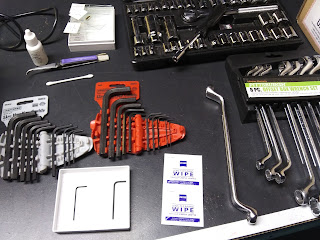By the end of this past school year, we had collected 7 microscopes that were not working well, or not working at all. As the science department head, I needed to do something about it. I really didn't want to schedule someone to come in to do microscope repair/maintenance since we're a relatively small private school with a smallish science budget. I wanted to maximize how much money we had for supplies and equipment.
Now, these microscopes are fairly old and don't owe us anything, so I decided to try my hand at microscope repair over this summer. I started a YouTube playlist of microscope cleaning and maintenance videos and started watching them to get an idea of how it may go.
After doing all of the summer prep that I wanted to do for my classes, it was time to tackle the microscopes. I had found a maintenance and repair video done by Wards, so I started with our Boreal microscope. This microscope's problem involved slipping out of focus. Once it was focused, the stage would start to slowly go down (and the image would go out of focus). This was remedied by a quick tightening of the focus knob with an allen wrench (AKA a hex key). This was super exciting, since I had that one working in under 5 minutes.
For every microscope, I wiped it down and cleaned each of the lenses with a drop of lens cleaning solution on a cotton swab. Actually, for one of the microscopes, the issue was a grossly dirty 40x objective lens. Maybe it got immersion oil on it? After a wipe down, the visual field was clear as a bell! Happily, all of the objective lenses unscrewed easily, which just made cleaning them less awkward than trying to do it while still attached. I just cleaned the lenses that faced out, only a few were dirty enough to clean the inside lens as well, but I tried to avoid that as much as possible.
We had two Labomed scopes whose views just looked like gray fuzz. No matter how much I moved the coarse or fine adjustment knobs, all I could see was gray fuzz. I wasn't sure what to do and decided to look up Labomed microscope repair and found exactly the instructions I need to do a focus stop repair. This was a little more involved, but the second one went much faster than the first. It helped to have already collected the correct tools.
Another problem was with a mechanical stage. The knob to move the slide forward and backward worked just fine, but the knob that moved it to the left or right kept slipping. A 7mm socket wrench worked great to tighten the nut under and inside the knob.
I didn't spend any money on supplies, I just raided my husband's tool supply, my craft supplies and some other items we had in the house. Here's my list...
- Hex Keys (allen wrench)...1.5 mm and 5/64 in
- offset box wrench...1/2 inch (although I think I probably could have used the socket wrench, but this was the first thing I found in my rummaging).
- socket wrench...7 mm
- cotton swabs
- (eyeglass) lens cleaner
- tweezers
- prepared microscope slides...had to go back to school for these since it's pretty hard to test a microscope with nothing to look at. :)





